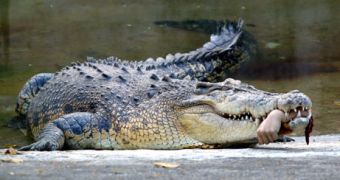Crocodiles do deserve they reputation: they hunt and eat everything, from fish and other small preys to buffalo and cattle; even lions were drawn and eaten by crocodiles. All this without mentioning the threat they pose to people. And a large meal can be enough for them for one year: crocodiles can ingest up to 23% of their body weight at once, including bones, teeth, hooves and all kind of stuff. Can you imagine an 80 kg (180-pound) man devouring a 19 kg (40-pound) hamburger in one meal?
Now, scientists have solved the mystery of this amazing ability. A research to be detailed in the March-April issue of the journal "Physiological and Biochemical Zoology" reveals how a heart valve that crocodiles can control neurologically lets blood bypass the lungs and go through a special aorta directly to the stomach, boosting by 10 times the speed of gastric acid, at a rhythm not found in other animals.
"Crocodiles, alligators and other crocodilians all share this ability," said biologist C. G. Farmer of the University of Utah, who discovered this phenomenon.
"It's been known for many years that reptiles can shunt blood past the lungs, but the function has not been understood," Farmer told LiveScience.
Scientists had believed the shunt was meant for long dives, but no research proved that.
"Some people in the field are pretty sure this is explained by diving, so I think they're going to be surprised," Farmer said. Farmer and her team surgically impeded some crocodiles' valve to skip the blood flow of the lungs. It appeared that crocodiles with an intact valve secreted gastric juices at a significantly increased rate. Blood skipping the lungs is rich in carbon dioxide, otherwise released in the lungs.
CO2 enters in the composition of gastric juice, accelerating its production, and the large amounts of gastric juice enable the crocs to properly digest large quantities of food.
"If any animal eats a meal that size, they can't process it immediately. As the meal is being broken down, the stomach holds on to the bulk of the food and sends little bits on to the intestine. If they weren't able to secrete a lot of acid in their stomachs, the food there would putrefy due to the overgrowth of bacteria. Eating big meals infrequently has selected for this ability," said Farmer.
The high acidity in the stomach of the crocodile enables the animal to dissolve even the bones of prey, and also hooves or feathers. Only teeth cannot be attacked by these powerful juices. The neurologically-controlled valve is specific to crocodilians, but a shunting system of any type may be encountered in other reptiles too for passing blood past the lungs. This should exist at least in the case of snakes and monitor lizards.
"It would be interesting to see if Burmese pythons also use the system for digestion, because they can eat meals that weigh more than 100% of their body mass. They do have a shunt system. It's just hard to study for technical reasons," said Farmer.

 14 DAY TRIAL //
14 DAY TRIAL //